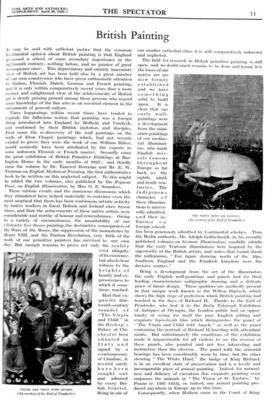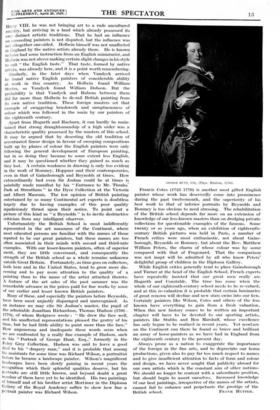British Painting
IT may be said with sufficient justice that the common Continental opinion about British painting is that England possessed a school of some secondary importance in the eighteenth century, nothing before, and no painter of great consequence since. This depreciatory and entirely inaccurate view of British art has been held also by a great number of our own countrymen who have given enthusiastic attention to Italian, Flemish, Dutch, German and French painting, and it is only within comparatively recent years that a more correct and enlightened view of the achievements of British art is slowly gaining ground among those persons who regard some knowledge of the fine arts as an essential element in the attainment of general culture.
Three happenings within recent times have tended to explode the fallacious notion that painting was a foreign thing introduced into England by Holbein and Vandyck, and continued by their British imitators and disciples. First came the re-discovery of the wall paintings on the walls of Eton Chapel, paintings which, had not records existed to prove they were the work of one William Baker, would assuredly have been attributed by the experts to some unknown Flemish or French master. Secondly came the great exhibition of British Primitive Paintings at Bur- lington House in the early months of 1925 ; and thirdly came the volume by Dr. Tancred Borenius and Mr. E. W. Tristram on English Mediaeval Painting, the first authoritative book to be written on this neglected subject. To this might be added the two volumes, also published by the Pegasus Press, on English Illumination, by Miss 0. E. Saunders.
These various events and the numerous discussions which they stimulated have helped materially to convince even the most sceptical that there has been continuous artistic activity by native workers in Great Britain and Ireland since Saxon times, and that the achievements of these native artists were considerable and worthy of honour and remembrance. Owing to a variety of circumstances, the unsuitability of our climate fo r fresco painting, the destructive consequences of the Wars of the Roses, the suppression of the monasteries by Henry VIII, and the Puritan Revolution, very little of the work of our primitive painters has survived to our own day. But enough remains to prove not only the r ea l i t y
VIRGIN AND CHILI) WITH ANGELS.
(By courtesy of the Earl of Pembroke.)
and ubiquity of its existence, but also to bear witness to the heights of beauty and ex- pressiveness to which it some- times reached. Had that ex- quisite thir- teenth-century roundel o f "The Virgin and Child " in the Bishop's Palace at Chi- chester been situated in Italy and signed by a Co n temporary of Cimabue, it would surely have been sought out and admired by every Bri- tish tourist. Being in one of our smaller cathedral cities it is still comparatively unknown and neglected.
THE WHITE 11150 (011 reverse). (By courtesy of the Earl of Pembroke.)
Being a development from the art of the illuminator, the early English wall-paintings and panels had for their leading characteristics calligraphic drawing and a delicate grace of linear design. These qualities are markedly present in that unique work known as the Wilton Diptych, which shows the high stage of perfection which British painting had reached in the days of Richard II. Thanks to the Earl of Pembroke, who lent it to the Daily Telegraph Exhibition of Antiques at Olympia, the London public had an oppor- tunity of seeing for itself the pure English gilding and exquisite lapis-lazuli blue which distinguishes the panel of " The Virgin and Child with Angels " as well as the panel containing the portrait of Richard II kneeling with attendant saints. But unfortunately the conditions of the exhibition made it impracticable for all visitors to see the reverse of these panels, also painted and not less interesting and instructive than the obverse. The panel with the armorial bearings has been considerably worn by time, but the other showing " The White Hind," the badge of King Richard, is in an excellent state of preservation and is a lovely and incomparable piece of animal painting. Indeed, for natural- ness and delicacy of execution this exquisite painting even surpasses the animals in " The Vision of St. Eustace," by Pisano (c. 1397-1455), or, indeed, any animal painting pro- duced anywhere in Europe up to this time. Consequently, when Holbein came to the Court of King
Henry VIII, he was not bringing art to a rude uncultured country, but arriving in a land which already possessed its own distinct artistic traditions. That he had an influence on succeeding painters is not disputed, but the influence was not altogether one-sided. Holbein himself was not unaffected in England by the native artists already there. He is known to have had some instruction from an English miniaturist, and Holbein was not above making certain slight changes in his style to suit " the English taste." That taste, formed by native artists, was already here, and it is a point worth remembering.
Similarly, in the later days when Vandyck arrived he found native English painters of considerable ability at work in this country. As Holbein found William Stretes, so Vandyck found William Dobson. But the probability is that Vandyck and Rubens between them did far more than Holbein to de-rail British painting from its own native tradition. These foreign masters set that example of swaggering brushwork and sumptuousness of colour which was followed in the main by our painters of the eighteenth century.
Apart from Hogarth and Raeburn, it can hardly be main- tained that strong draughtsmanship of a high order was a characteristic quality possessed by the masters of this school. It may be argued that by deserting the old tradition of accentuated linear design in favour of sweeping compositions built up by planes of colour the English painters were only following the general development of European painting, but in so doing they became to some extent less English, and it may be questioned whether they gained as much as they lost. A certain weakness in drawing is only too evident in the work of Romney, Hoppner and their contemporaries, even in that of Gainsborough and Reynolds at times. How extraordinarily bad even Sir Joshua could be at times is painfully made manifest by his " Entrance to Mr. Thrales' Park at Streatham " in the Dyce Collection at the Victoria and Albert Museum. The low opinion of British painting entertained by so many Continental art experts is doubtless largely due to having examples of this poor quality injudiciously thrust upon their notice. To point out a picture of this kind as " a Reynolds " is to invite destructive criticism from any intelligent observer.
Unfortunately the British School is most indifferently represented in the art museums of the Continent, where most educated persons are familiar with the names of those reputed to be our great painters, but these names are too often associated in their minds with second and third-rate examples. With our lesser-known painters, often of superior merit, they are little conversant, and consequently the strength of the British school as a whole remains unknown outside Great Britain. Fortunately, as time goes on collectors, both here and in the United States, tend to grow more dis- cerning and to pay more attention to the quality of a painting than to the name of the artist attached thereto. A feature of the art sales of the past summer was the remarkable advance in the prices paid for fine works by some of our earlier and lesser known British painters.
Many of these, and especially the painters before Reynolds, have been most unjustly disparaged and unrecognized. As an instance we may cite Sir Joshua's master, the pupil of the admirable Jonathan Richardson, Thomas Hudson (1701- 1779), of whom Redgrave wrote : " He drew the face well, and his unaffected representations pleased the gentry of his time, but he had little ability to paint more than the face." How ungenerous and inadequate these words seem when we are confronted by a really fine example of Hudson, such as his " Portrait of George Hunt, Esq.," formerly in the Foley Grey Collection. Hudson was said to leave a good deal to his " drapery man," and it is probable that among his assistants for some time was Richard Wilson, a portraitist before he became a landscape painter. Wilson's magnificent landscapes have been slowly gaining in recent years the recognition which their splendid qualities deserve, but his Portraits are still little known, and beyond doubt a great number of them have yet to be identified. His two paintings of himself and of his brother artist Mortimer in the Diploma Gallery of the Royal Academy suffice to show how fine a Portrait painter was Richard Wilson. GEORGE HUNT, FSQ. (Thos. Hudson, 1750).
Francis Cotes (1725-1770) is another most gifted English painter whose work has deservedly come into prominence during the past twelvemonth, and the superiority of his best work to that of inferior portraits by Reynolds and Romney is too obvious to need stressing. The rehabilitation of the British school depends far more on an extension of knowledge of our less-known masters than on dredging private collections for questionable examples of the famous. Some twenty or so years ago, when an exhibition of eighteenth- century British pictures was held in Paris, a number of French critics were most enthusiastic, not about Gains- borough, Reynolds or Romney, but about the Rev. Matthew William Peters, the charm of whose colour was by some compared with that of Fragonard. That the comparison was not inapt will be admitted by all who know Peters' delightful group of children in the Diploma Gallery.
While English critics generally tend to place Gainsborough and Turner at the head of the English School, French experts have repeatedly insisted that our great men really are Hogarth and Constable. The time has come when the whole of our eighteenth-century school needs to be re-valued, and at this re-valuation it is probable that certain luminaries of great renown will decline and new stars swim into our ken. Certainly painters like Wilson, Cotes and others of the less known have everything to gain from a fresh valuation. When this new history comes to be written an important chapter will have to be devoted to our sporting artists, painters like Stubbs and Ben Marshall, whose excellence has only begun to be realized in recent years. Yet nowhere on the Continent can there be found so brave and brilliant an array of horse-painters as we have had in England from the eighteenth century to the present day.
Always prone as a nation to exaggerate the importance of the foreign in the fine arts, and to depreciate our home productions, given also to pay far too much respect to names and to give insufficient attention to facts of form and colour and design, we have never sought that publicity abroad for our own artists which is the constant aim of other nations. We should no longer be content with a subordinate position, but should begin to assert ourselves. Increased knowledge of our best paintings, irrespective of the names of the artists, cannot fail to enhance and perpetuate the prestige of the British school. FRANK RUTTER.

























































 Previous page
Previous page